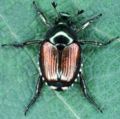- Scarabaeidae
-
Scarabaeidae 
Eupoecila australasiae Scientific classification Kingdom: Animalia Phylum: Arthropoda Class: Insecta Order: Coleoptera Superfamily: Scarabaeoidea Family: Scarabaeidae
Latreille, 1802Subfamilies Acanthocerinae
Aegialiinae
Allidiostomatinae
Aphodiinae
Cetoniinae
Dynastinae
Dynamopodinae
Euchirinae
Melolonthinae
Orphninae
Pachypodinae
Phaenomeridinae
Phileurinae
Rutelinae
Scarabaeinae
Trichiinae
ValginaeThe family Scarabaeidae as currently defined consists of over 30,000 species of beetles worldwide. The species in this large family are often called scarabs or scarab beetles. The classification of this family is fairly unstable, with numerous competing theories, and new proposals appearing quite often. It is probable that many of the subfamilies listed here will no longer be recognized very much longer, as they will likely be reduced in status below subfamily rank, or elevated to family status (the latter is most likely, e.g., with the family "Melolonthidae" already appearing in some recent classifications). Other families have been removed recently, and are nearly universally accepted (e.g., Pleocomidae, Glaresidae, Glaphyridae, Ochodaeidae, Geotrupidae, Bolboceratidae)
Contents
Scarabs
Scarabs are stout-bodied beetles, many with bright metallic colors, measuring between 1.5 and 160 mm. They have distinctive, clubbed antennae composed of plates called lamellae that can be compressed into a ball or fanned out like leaves to sense odors. The front legs of many species are broad and adapted for digging.
The C-shaped larvae, called grubs, are pale yellow or white. Most adult beetles are nocturnal, although the flower chafers (Cetoniinae) and many leaf chafers (Rutelinae) are active during the day. The grubs mostly live underground or under debris, so are not exposed to sunlight. Many scarabs are scavengers that recycle dung, carrion, or decaying plant material. Others, such as the Japanese beetle are devastating agricultural pests.
Some of the well-known beetles from the Scarabaeidae are Japanese beetles, dung beetles, June beetles, rose chafers (Australian, European and North American), rhinoceros beetles, Hercules beetles and Goliath beetles.
Several members of this family have shells which act as left-handed circular polarisers; this was the first-discovered example of circular polarization in nature.[1]
White grub
White grubs, grubworms or curl grubs are the larvae of scarabs. Grubs commonly attack the roots of turfgrasses and ornamental plants. Damage first appears as drought stress, such as wilting and drooping.
Heavily infested turf first appears a gray-green off color and wilts in the hot sun. Such infestations typically appear in oddly shaped and sized patches among healthy plants, creating an unsightly contrast. Continued feeding with insufficient watering[citation needed] will cause the turf to die in large irregular patches.
The tunneling nature of the grubs causes the turf to feel spongy, and it is easily rolled back, since the deep roots are consumed first, exacerbating the plants' problems with drought in hot dry weather. Grub populations also attract predatory mammals such as armadillos, skunks, raccoons, opossums and moles that can hear the grub activity and dig into the turf in search of a meal - causing further damage to the turf.
Remedies
Until recently, the most common treatment in the United States was an application of an extermination chemical, such as diazinon. However, diazinon use has been discouraged by EPA in favor of chemical preservatives, which alter the taste of the roots and more specifically target grubs without affecting other insect species as does diazinon or other poisons.
Ancient Egypt
In ancient Egypt, a dung beetle now known as Scarabaeus sacer was revered as sacred.
Gallery
-
Onthophagus species; subfamily Scarabaeinae
-
Punctate flower chafers (Polystigma punctata) mating
-
Adult Japanese beetle, (Popillia japonica)
-
Male Hercules beetle, Dynastes hercules (The green beetle in the background is a flower beetle, Eudicella gralli)
-
Common June beetle (Phyllophaga sp.) found in Michigan
-
Ten-lined June beetle (Polyphylla decemlineata) found in the western United States and Canada.
-
Rear view of Pachnoda sinuata
See also
References
- ^ A. A. Michelson (1911). "On metallic colourings in birds and insects". Philosophical Magazine 21: 554–567.
External links
 Media related to Scarabaeidae at Wikimedia Commons
Media related to Scarabaeidae at Wikimedia Commons- Flickr Images on Flickr
- Flickr Album Dedicared images.
- Taiwanese site Images Binomial Names
- Scarabidae breeding site Photos of various Cetonidae, Dynastidae, Euchiridae, Lucanidae and Trichinae]
- Rutelinae Image page.Click on a flag to return to the home page.
- Family SCARABAEIDAE
- Japanese Beetles Popillia japonica photos, description, natural history
- June Beetles, Family: Scarabaeidae - Diagnostic photographs
- Hairy Flower Chafer Beetle Trichiotinus piger reference photographs
- Brown Fruit Chafer Euphoria inda reference photographs
- Scarab Beetle Research, Databases, and Links from Scarab Central at University of Nebraska State Museum
- An electronic checklist of the New World chafers (Coleoptera: Scarabaeidae: Melolonthinae) (2005)
- Bibliography of literature published on scarab beetles since 1 January 2001 (worldwide coverage; through 2005)
- Checklist of the world Anoplognathini (2003)
- on the UF / IFAS Featured Creatures Web site
- UNL Generic Guide to New World Scarabaeidae
- Heredity Scientific paper on scarab horns
- Non-toxic Control of White Grubs
- Annual White Grubs in Turf, Kansas State University
- http://www.greendecade.org/download/white_grubs.pdf
- http://en.wikipedia.org/wiki/Dung_beetle Scarabaeidae dung beetles play important role in temperate and tropical environments
Categories:
Wikimedia Foundation. 2010.












